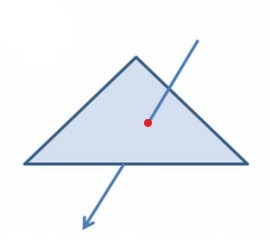Raycast Detection
Raycast detection is a intersection determination of one ray and another shape, as shown in the figure below.

Construct Rays
A ray consists of a starting point and a direction. There are several more common ways to construct a ray, as follows:
via the constructor of start + direction, ray or the static interface
create.tsimport { geometry } from 'cc'; // Construct a ray starting from (0, -1, 0) and pointing to the Y-axis // the first three arguments are the starting point, the last three arguments are the direction const outRay = new geometry.Ray(0, -1, 0, 0, 0, 1, 0); // or by static method 'create' const outRay2 = geometry.Ray.create(0, -1, 0, 0, 0, 1, 0);via the static interface
fromPointsof start point + another point on ray, ray:tsimport { geometry, math } from "cc"; // Construct a ray that points to the Z-axis from the origin const outRay = new geometry.Ray(); geometry.Ray.fromPoints(outRay, math.Vec3.ZERO, math.Vec3.UNIT_Z);Use the camera to construct a ray emitted from the camera origin to a point on the screen.
tsimport { geometry, Camera } from "cc"; // Take the example of a script mounted under Camera const camera = this.node.getComponent(Camera); // Get a ray emitted from the screen at (0, 0) const outRay = new geometry; camera?.screenPointToRay(0, 0, outRay);Note.
- First you need to get a reference to a camera component or camera instance.
- The order of the interface parameters exposed by the camera component and the camera instance are different.
Interface Introduction
Cocos Creator provides a set of raycast detection functions based on the physics engine.
The interface is currently provided by PhysicsSystem and has the following two classes.
raycast: Detects all colliders and records all detected results, obtained viaPhysicsSystem.instance.raycastResults. The interface returns a boolean value indicating whether if the ray intersects with any collider or not.raycastClosest: detects all colliders and records the result of the detection with the shortest distance to the ray, obtained viaPhysicsSystem.instance.raycastClosestResult. Also returns a boolean value same asraycastmethod.
Note.
- The detected object is a physical collider, and the corresponding collider component in the scene panel is a collider component, e.g. BoxCollider.
- The object returned by the detection result is read-only and reused, and the corresponding result is updated after each call to the detection interface.
Common examples of raycast detection of nearest objects based on camera position and screen coordinates.
let ray = new geometry.Ray();
this.camera.screenPointToRay(eventMouse.getLocationX(), eventMouse.getLocationY(), ray);
// The following parameters are optional
const mask = 0xffffffff;
const maxDistance = 10000000;
const queryTrigger = true;
if (PhysicsSystem.instance.raycastClosest(ray, mask, maxDistance, queryTrigger)) {
const raycastClosestResult = PhysicsSystem.instance.raycastClosestResult;
const hitPoint = raycastClosestResult.hitPoint
const hitNormal = raycastClosestResult.hitNormal;
const collider = raycastClosestResult.collider;
const distance = raycastClosestResult.distance;
}The following code demonstrates how multiple objects can be detected:
const worldRay = new geometry.Ray(0, -1, 0, 0, 1, 0);
// The following parameters are optional
const mask = 0xffffffff;
const maxDistance = 10000000;
const queryTrigger = true;
const bResult = PhysicsSystem.instance.raycast(worldRay, mask, maxDistance, queryTrigger);
if(bResult){
const results = PhysicsSystem.instance.raycastResults;
for (let i = 0; i < results.length; i++) {
const result = results[i];
const collider = result.collider;
const distance = result.distance;
const hitPoint = result.hitPoint;
const hitNormal = result.hitNormal;
}
}Parameter Description
worldRay: the ray in the world spacemask: mask for filtering, you can pass in the group to be detected, default is 0xffffffffmaxDistance: the maximum detection distance, default is 10000000, do not passInfinityorNumber.MAX_VALUEat this timequeryTrigger: whether to detect the trigger
Result Description
The result of the ray detection is stored by PhysicsRayResult, mainly with the following information.
collider: the collider that hitdistance: the distance between the hit point and the start of the rayhitPoint: the hit point (in the world coordinate)hitNormal: the normal of the face where the hit point is located (in the world coordinate)
Related test cases can be found in the GitHub repo.